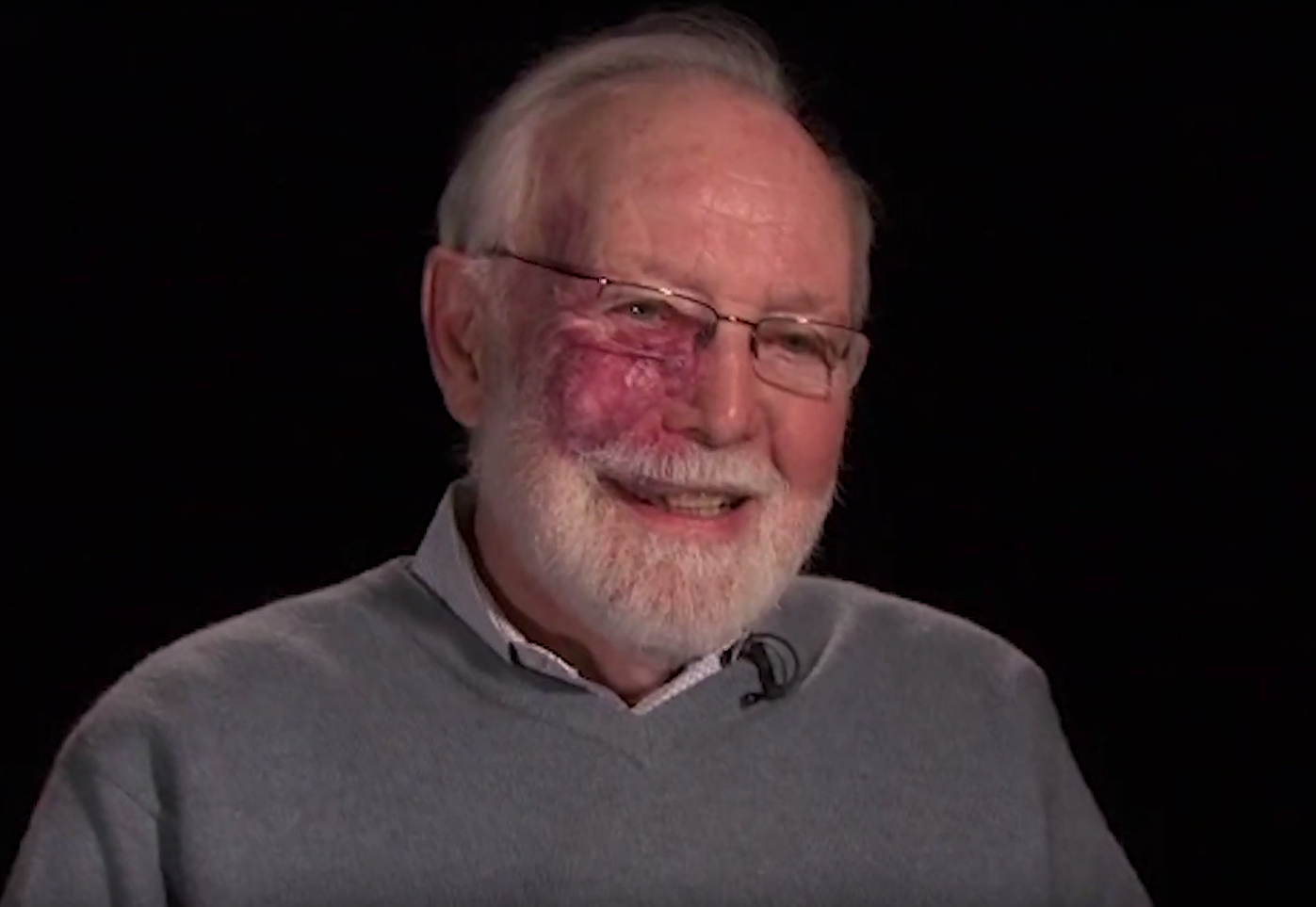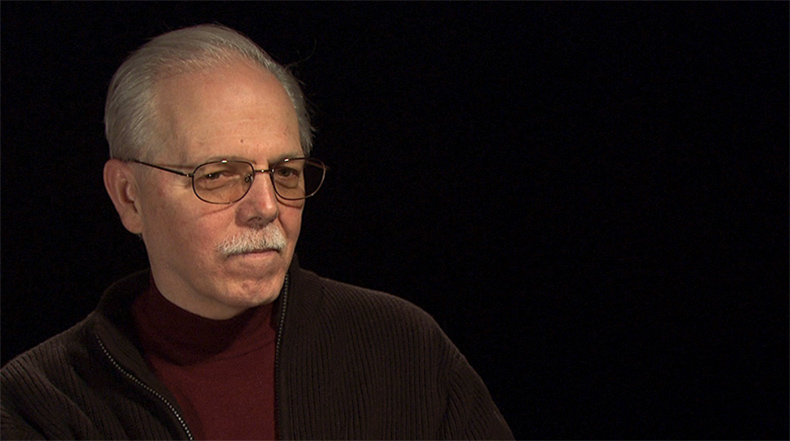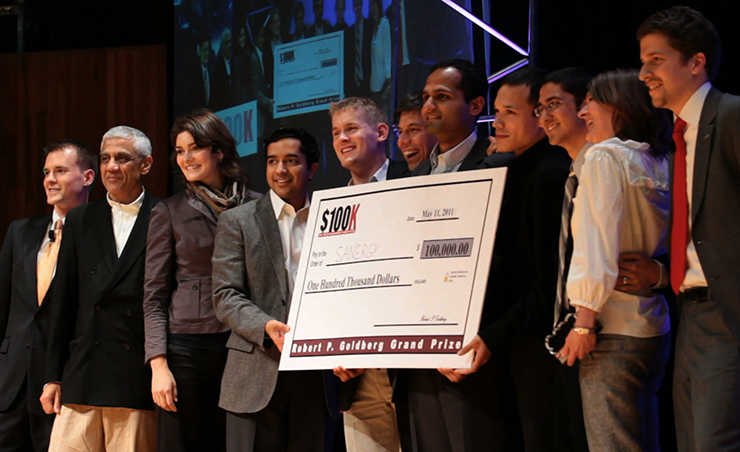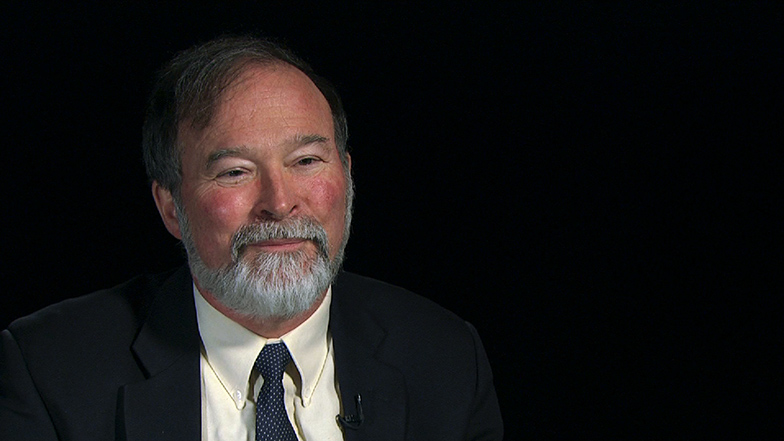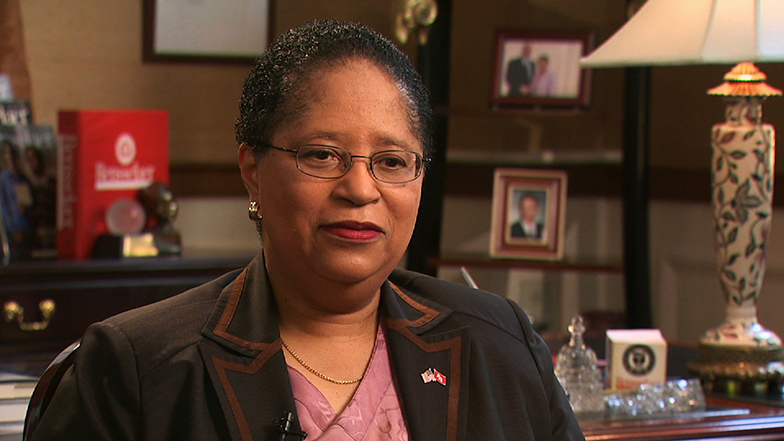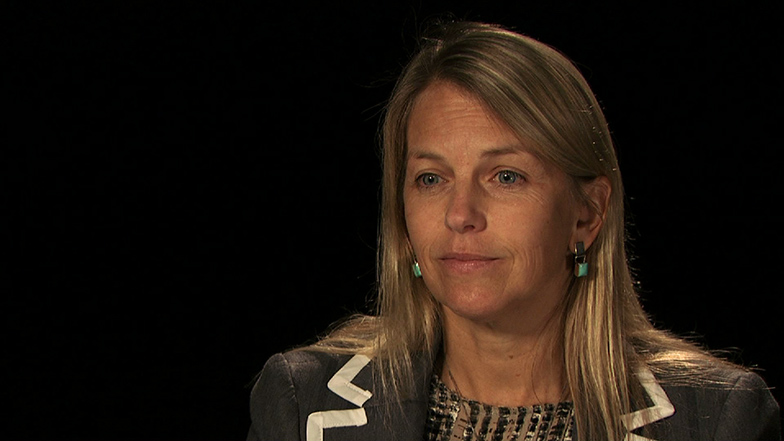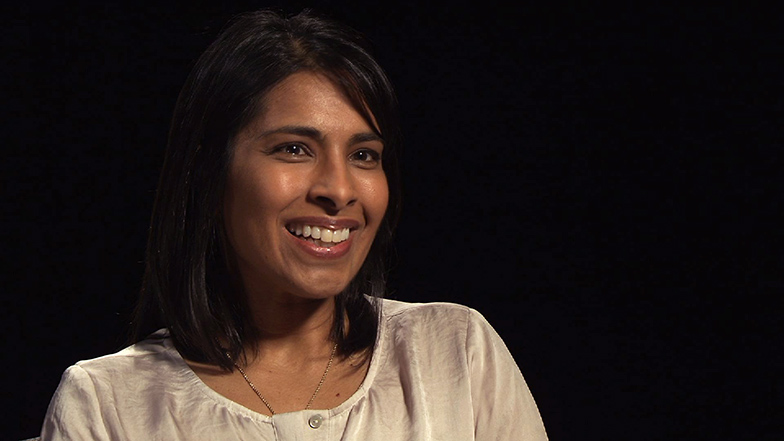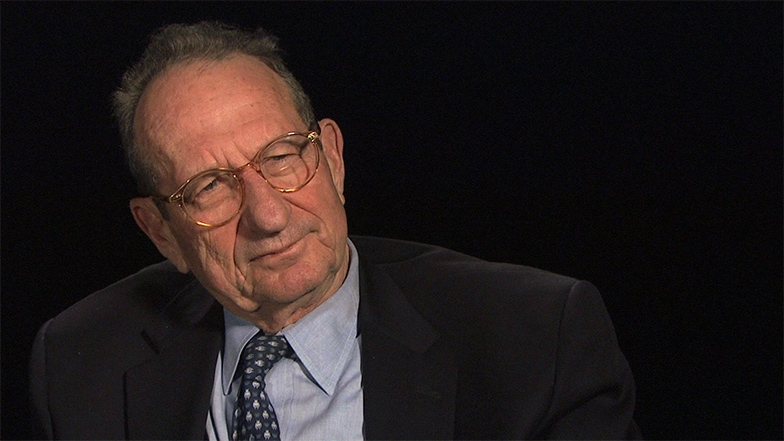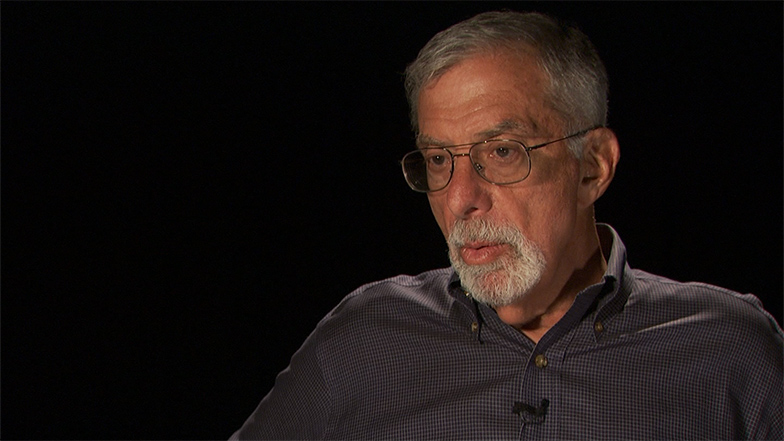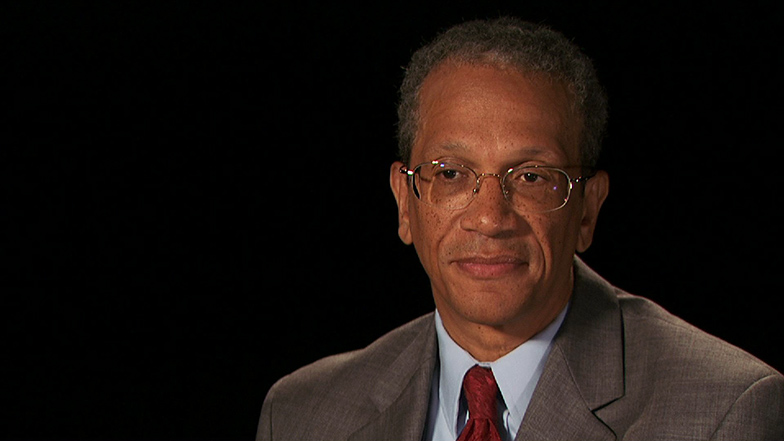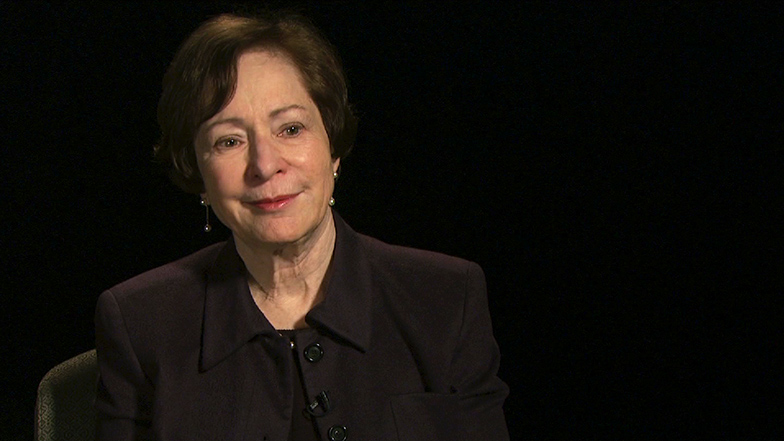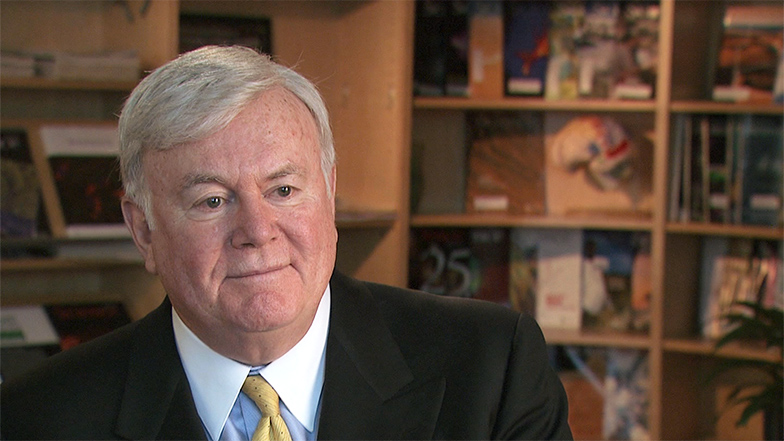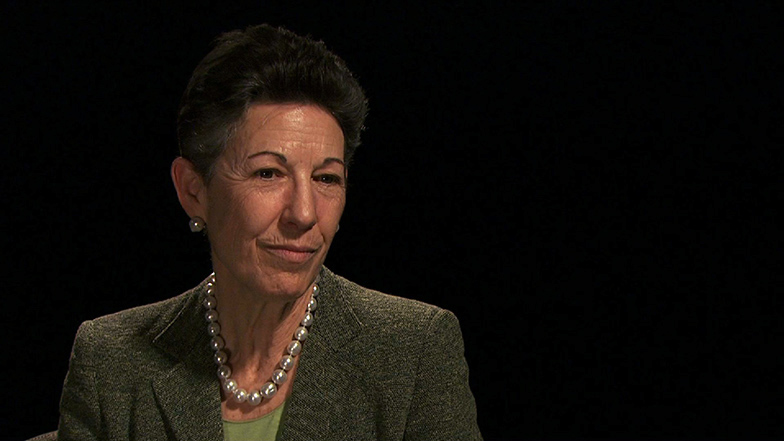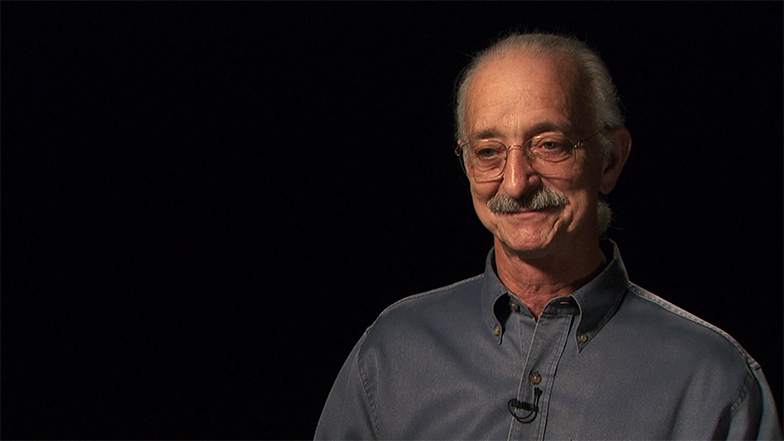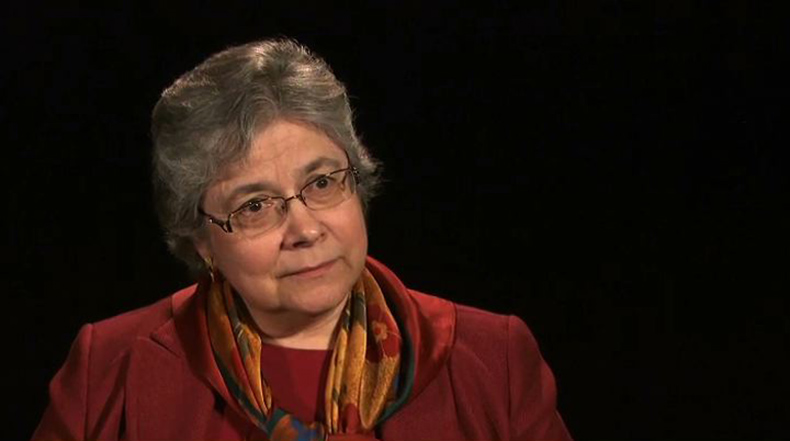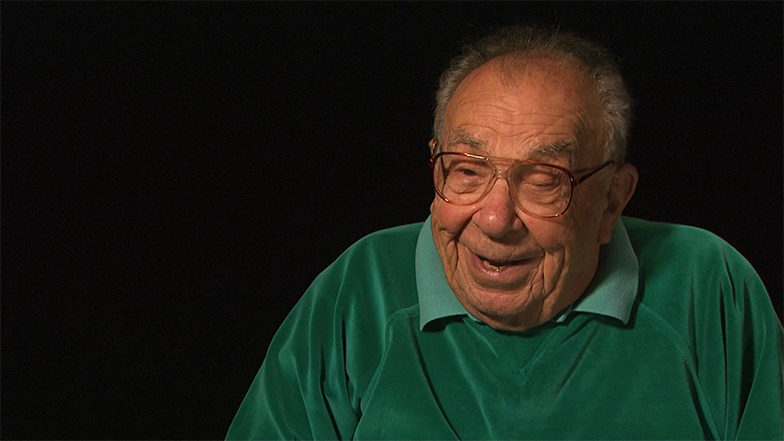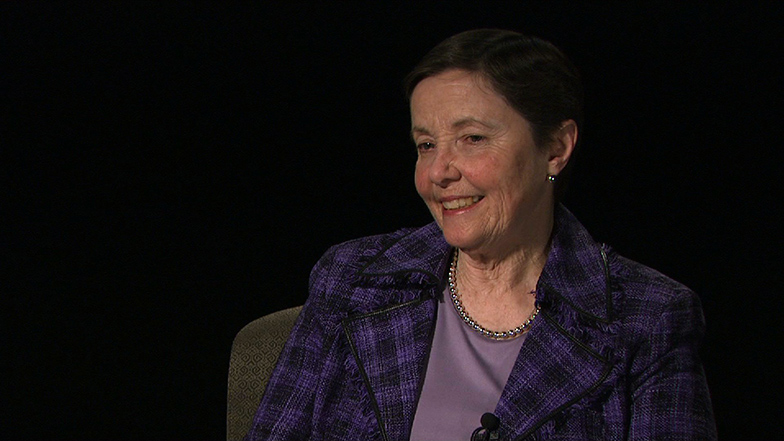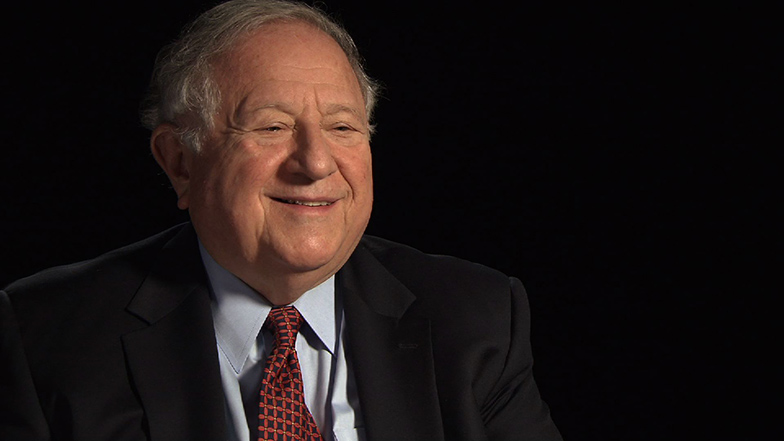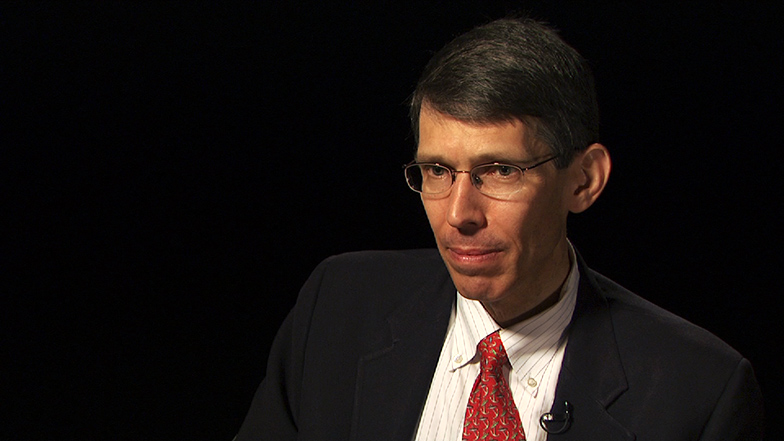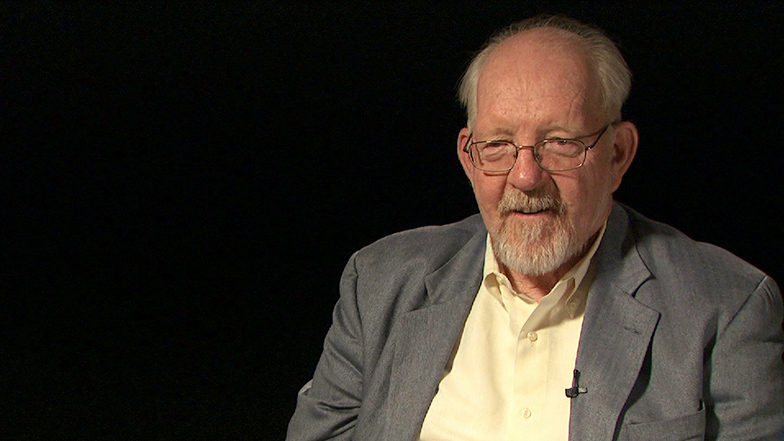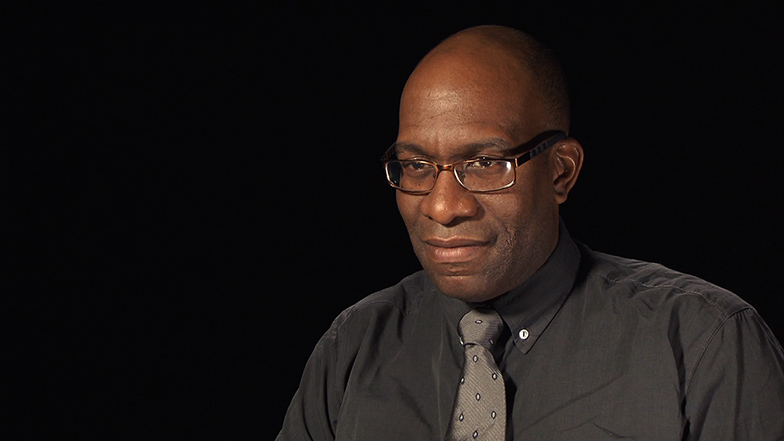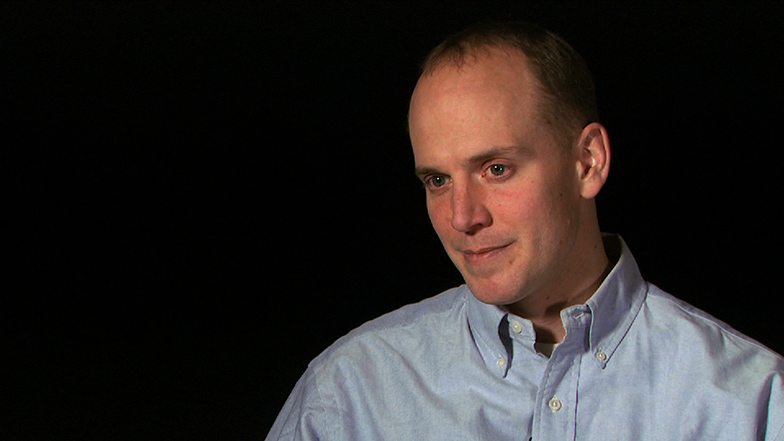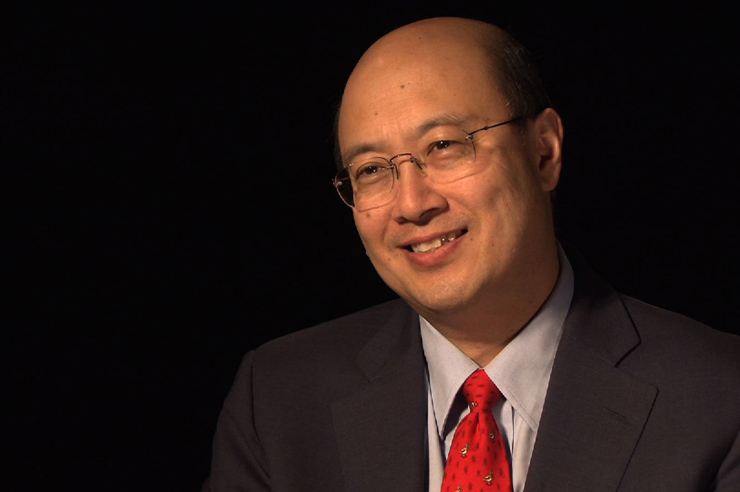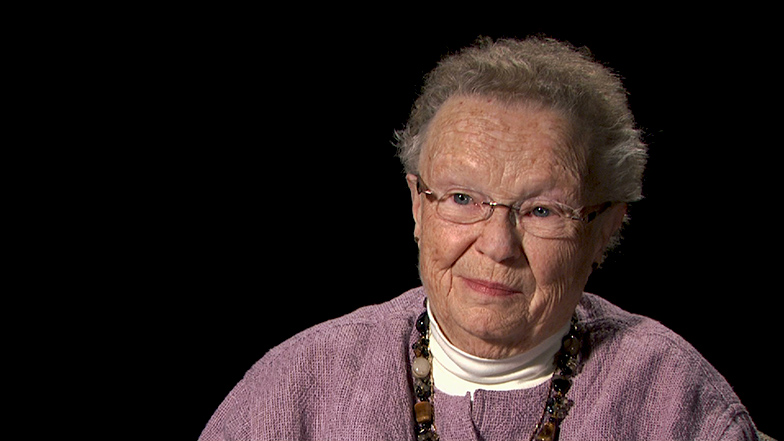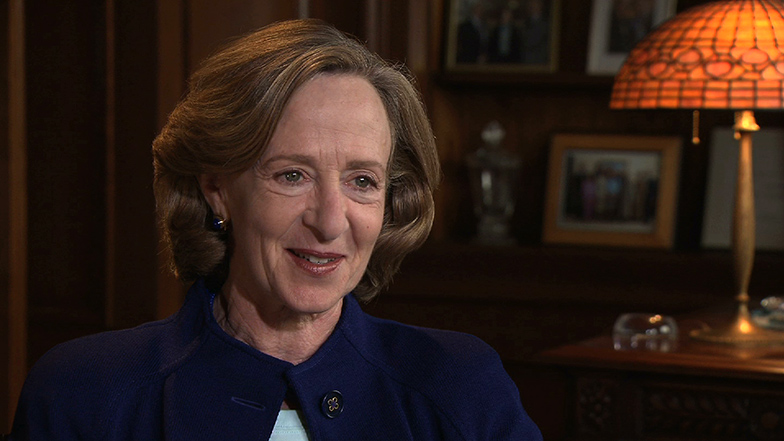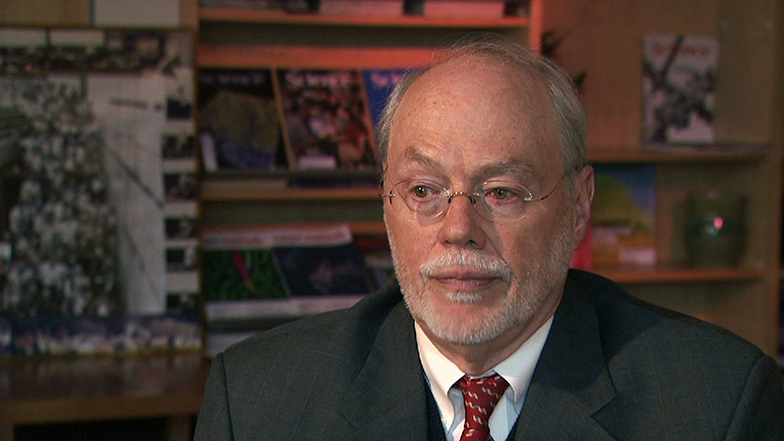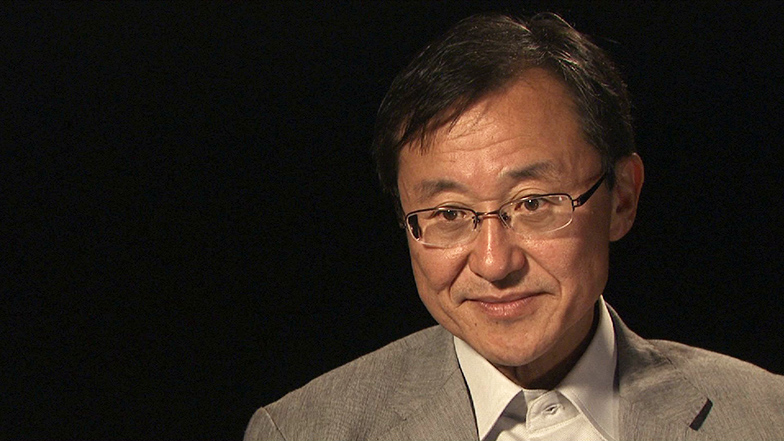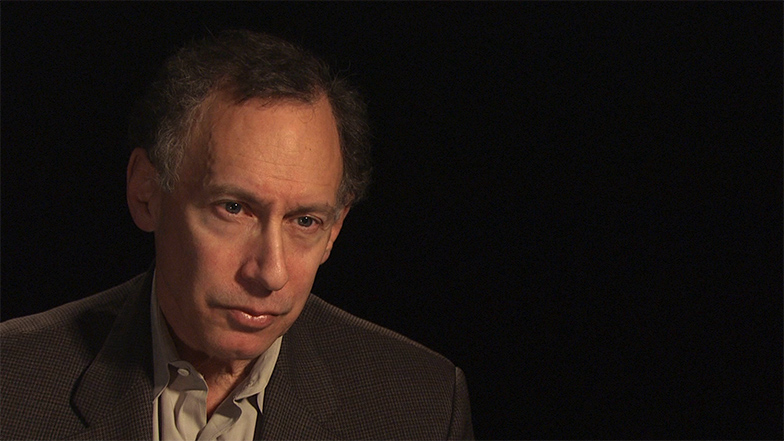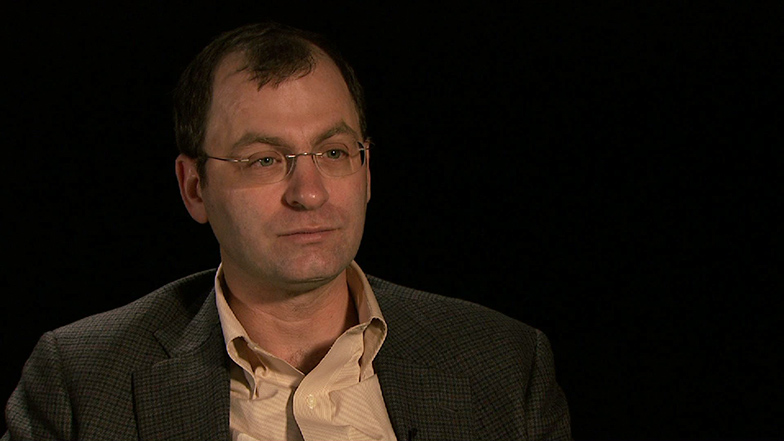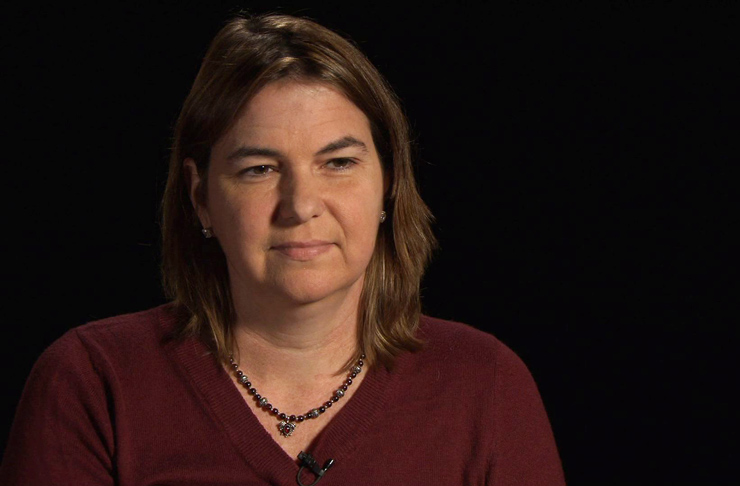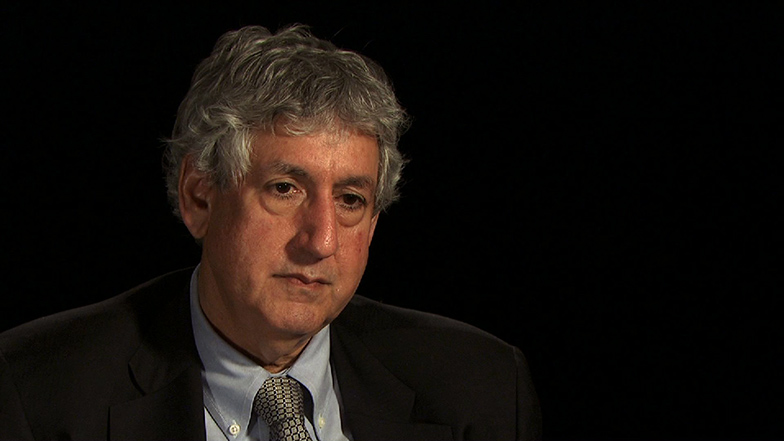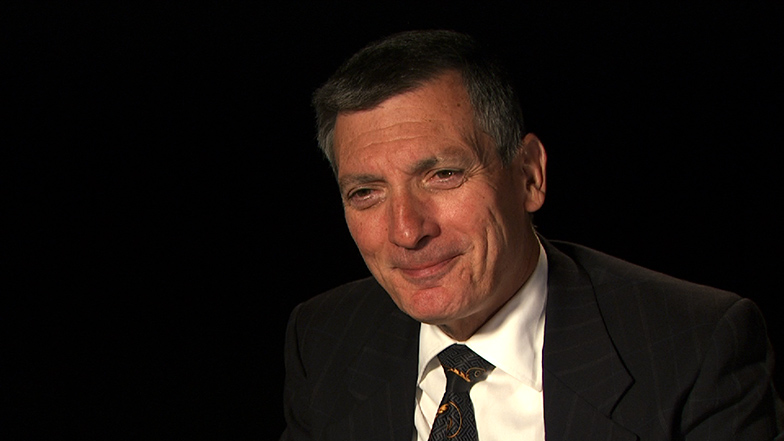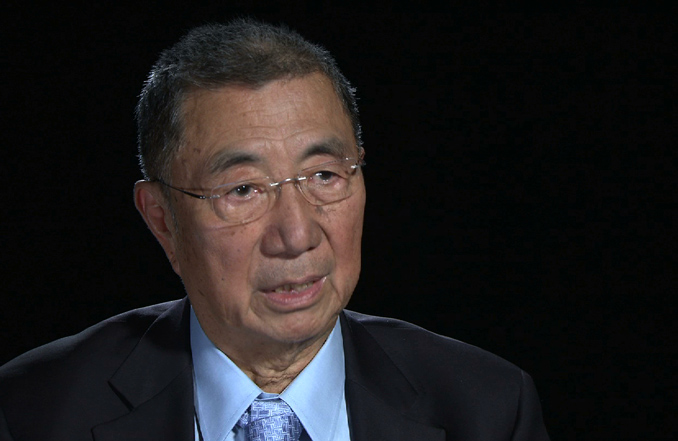Robert Redwine
INTERVIEWER: So this is the 150 anniversary celebration with professor Robert Redwine. Let me start out by asking you where you were born and where did you grow up?
REDWINE: So I was born in Raleigh, North Carolina. My parents were both from the south, my father's family mostly in Georgia, my mother's family mostly in Alabama. They had met, actually, in Washington, D.C. during the war, and they married soon after that and decided to pick a place that was in the south, but maybe not the deep south where they were from. So they settled on Raleigh. I think they went there without having a job at the time, but eventually everything worked out. We lived there until I was seven years old in an old farmhouse. Then my father got involved in politics as a member of staff of a guy who was the governor of North Carolina. When he was elected to the Senate, we moved to the Washington area. I graduated from high school in Northern Virginia.
INTERVIEWER: Are there any particular influences that you remember from childhood which you think kind of put you on your career path?
REDWINE: I think the only thing probably was my parents. Neither one of my parents had much education. My mother graduated from high school, my father never really went to school very much, although I wouldn't say he was uneducated. His mother was a pretty remarkable person and she did a lot of what we would call home schooling now. So they came through the system then without a lot of credentials, but they both thought very highly of education. I would say especially my mother, she really expected a lot of my sister and me.
I was just brought up to think as long as I worked hard I could do whatever I wanted to do. But education was key. That probably was the main influence. Certainly neither of my parents knew much about science. They hadn't had the opportunity to. I just found that I liked that myself.
INTERVIEWER: What was it that made you decide to go to Cornell?
REDWINE: Again, I graduated from high school in Northern Virginia, and those were pretty good schools in those days. A lot of my classmates in high school went to a university, most did, a variety of universities. I had the feeling, and I must admit I don't know exactly the origin now, but I really did want to go north to experience something different. And I also had the feeling that I wanted to not be in an urban area. I had spent the last 10 years or so in an urban area, in Washington D.C., so Cornell fit pretty well. It's certainly not in an urban area.
INTERVIEWER: Kind of in the middle of nowhere.
REDWINE: Ithaca is an interesting place. But it's isolated.
INTERVIEWER: When you were there what was it that drew you to physics?
REDWINE: I just loved it. Of all the classes I was taking, this was the one I most enjoyed. And that was true from the beginning. I also should say that I did have a really interesting experience in high school physics. When I was a senior, my high school introduced what was called Physical Sciences Study Committee in physics or PSSC physics. This was actually a curriculum that was developed at MIT by Jerrold Zacharias and colleagues in the years after Sputnik. There were various efforts in the sciences to produce more hands-on, exciting curricula for high schools.
I was lucky enough to come along when this was first introduced in my high school. It was just a revelation because it was very hands -on, very practical, things made sense. To me it was just a revelation. So in some sense the start in physics really came in high school not at Cornell. Obviously I enjoyed it at Cornell as well.
INTERVIEWER: In that particular course do you think it was the subject matter, the curriculum itself that interested you? Or do you think it was the fact that it was a more hands- on approach to teaching?
REDWINE: Well I think it's hard to separate entirely, but certainly the idea of PSSC was that you don't memorize a whole lot of things. You really try to figure out what the concepts are. What the essentials of what's going on in various situations are. And this was very unlike my experience, and it was the experience a lot of students had with biology and chemistry, for example, which we had typically taken before physics. Where it just, at that time at least, was an awful lot of just memorization. It could get pretty unexciting. At least to me. So I think that was the essential part.
Zacharias and his colleagues did a remarkable job. The problem with PSSC-- it did not stick. It lasted a few years but there are very few high schools around the country now that use it. The problem was that it required a really highly trained and motivated teacher to make it work. It was just asking a lot of the average physics teacher, most of whom even today have never earned a degree in physics, even an undergraduate degree. So this remains a problem. Unfortunately PSSC did not make a huge impact over a long period of time, but it certainly made a huge impact on me.
INTERVIEWER: Did you get to do a lot of hands-on research and study as a physics major at Cornell?
REDWINE: Honestly not so much. What we now see as the UROP program at MIT, which of course has been copied at a lot of other universities, was not so common in those days. And I did not do any research in labs at Cornell and I don't remember any of my colleagues who were physics majors doing it as well. We certainly had laboratory courses. We had a course that corresponds pretty closely to what we call junior lab at MIT, but anything like UROP was certainly not common in those days.
INTERVIEWER: So after undergrad, what made you decide you wanted to go to graduate school?
REDWINE: I think that I was just having so much fun doing physics. I can't claim that I thought long term about a career. I really didn't. Certainly my family they were extremely supportive in terms of what I wanted to do, but they weren't in a position to offer advice as to what it meant to be a scientist, what it might mean to be a professor one day. I just was having a lot of fun studying physics, doing physics. I was doing pretty well, so I had the opportunity to go to graduate school. It just seemed like the obvious next step. I wish I could say I thought more deeply about it than that, but I did not.
INTERVIEWER: You were 22?
REDWINE: Exactly.
INTERVIEWER: Why did you pick Northwestern?
REDWINE: Well, they accepted me. Not every place did. And they also offered a nice scholarship, I visited and I like the area, I liked the university. It seemed like a good fit.
INTERVIEWER: While you were in school were there any particular mentors or influential professors besides the course in high school?
REDWINE: I think the one to point out, and it's fairly obvious, is my PhD adviser at Northwestern. He was certainly extremely supportive in a variety of ways, not just intellectually. He is a pretty savvy guy. He's still fortunately alive and we're in contact. He's retired now, but he was a great help. He really was, not just on the physics side. He taught me a lot about what I might expect in the profession, for example.
INTERVIEWER: So how did you wind up doing postdoc work at Los Alamos?
REDWINE: So I got my PhD in experimental nuclear physics. At that time, this was 1973, there was a brand new accelerator at Los Alamos which was really just turning on. I'll get back to that in a moment. But in our field, we really depend on these large accelerators to provide new capabilities, new opportunities to study things that weren't available before. So it's a really exciting time when a major new capability becomes available. My timing, I was extremely fortunate. I finished my PhD just when this new accelerator was about to turn on. So to me it was just a terrific opportunity. The best I could imagine. So I jumped at the opportunity to go to Los Alamos.
The accelerator was called the Los Alamos Meson Physics Facility. We use acronyms all the time so it was LAMPF. I arrived in August, 1973. I can't tell you the exact date, but I remember it was a Sunday evening. And the first pions, which were particles I used for a number of years, were produced by the accelerator on Monday and I was there. So the next few years were very exciting.
INTERVIEWER: And then you wound up going to Switzerland. How did that happen?
REDWINE: That's an interesting story. Again I think I was very lucky. So one of the characteristics of LAMPF, this accelerator, was that it produced many more protons than any other accelerator had produced before, so lots of power in the beam. And power in the beam raises radioactivity issues. Protons in particular produce a significant amount of radioactivity when they hit anything, basically.
So people knew this from the beginning, and the plan was to run the accelerator for the first year or so at reduced current so that a lot of measurements of radioactivity in the area could be made. Because people have to work nearby in shielded areas. And after those measurements were completed, then the final shielding was to be put in place before the beam current went up to its maximum value.
So that in fact happened. But they found after they made the measurement for the first year or so while we were doing experiments with reduced current, that they actually had a more extensive shielding job than they thought they did. And so they were going to be shut down for, they thought a year, it turned out to be about 16 months. And so I had come to know a lot of scientists there, and at the time Switzerland was building a similar but complementary accelerator. That was a year or two or so after the accelerator in Los Alamos was turning on.
And some of my colleagues who were about the same age, and were postdocs in Switzerland were going back. One of them said, look we have a position in my group at the University of Bern, would you like to come for a year? And so it sounded like a great opportunity scientifically and personally, and so I actually went to the director of the lab at Los Alamos and explained the situation. He was a remarkable guy. He actually died just a few months ago. His name was Louis Rosen.
And what I asked him was could we sort of suspend my postdoc? I'll be gone for a year and then I'll come back. He said, well I don't really think there's a mechanism to formally suspend it, but I understand what you want to do is reasonable. So if you resign your postdoc and then a year from now you want to come back then we'll have a handshake agreement. We'll definitely hire you. So that's exactly what happened. I was gone for a year and then came back and rejoined my postdoc at Los Alamos.
INTERVIEWER: Can you talk anymore about after you returned? Is there anything more to say about the work you were doing there?
REDWINE: Well again, both of these accelerators, both in Switzerland-- by the way, the accelerator in Switzerland is near Zurich --and the one in Los Alamos, they were high current proton accelerators. And they did complementary things. One was a circular machine, the one in Switzerland, in Los Alamos it was a linear accelerator. They had different timing characteristics, and this can be important to do one experiment or another.
Most of what I did on both accelerators, actually, involved the use of particles call pions and muons. When a proton hits any material actually, at least an energetic proton, it will produce pions. Pions are short-lived particles that were just predicted by Yukawa many years ago and found soon after. In many ways, we think of them as holding together the protons and neutrons in the nucleus. So it was very important to study the interactions of real pions produced by accelerators with nuclei.
The other thing pions do is when they decay, they decay into a muon and a neutrino. We like to use both muons and neutrinos to do different experiments. So in fact we use those as well. Again, because we had so many more protons in the beam than anybody had before, we had more pions and muons and neutrinos than anyone had before as well. It was just a wonderful time doing experiments that just hadn't been accessible prior to that.
INTERVIEWER: Did you worry at all about your exposure to radiation?
REDWINE: Well, people have been pretty careful since the early days. I would say when the particle accelerators started in the 30s, 40s, and 50s probably the field did not know quite as much as they should have about the effects of radiation. In particular the chances of developing cancer down the road. So I think looking back there certainly were some precautions that should have been taken that people just didn't know to take.
If you look at one of the early accelerators at MIT, the Van de Graaff accelerator that was built by Robert Van de Graaff and his colleagues in the mid 20th century, many of the people, not that there were hundreds, but many of the people who worked on that accelerator did die of cancer probably a bit prematurely. There's little doubt that contributed. But that was in the 40s and 50s.
We know a lot more now, and we certainly knew a lot by the 70s. So I made lots of precautions. The amount of radiation I was getting was always being monitored. The truth is flight attendants and pilots who fly long distance get more radiation than we did then from the accelerator. People who are in airplanes a lot get it from cosmic rays because they are high in the atmosphere.
INTERVIEWER: So how did you wind up coming to MIT?
REDWINE: After I spent the year in Switzerland, and I actually went back for a few months at a time to continue doing experiments there, but I didn't move back to Switzerland, I was living in Los Alamos. I was happily doing experiments there and I had, by that time moved from a postdoctoral position to a regular staff position at the laboratory. And I must say I loved the scientific opportunities and I also liked the area. Northern New Mexico is a very special area in a variety of ways. So I very much enjoyed that.
But a number of the people who were also doing experiments at Los Alamos were from MIT. So I got to know them. And at some point probably around 1978 they began mentioning that they expected to have a faculty position and would I be interested? So I did come and interview and talked to people and eventually received an offer. I actually turned it down. I mean, in writing I turned it down.
And Herman Feshbach was head of the physics department at that time, and I had gotten to know him because he was much senior to me, but he was a nuclear theorist and a very approachable nuclear theorist that I had met at various conferences and at Los Alamos. It was typical in those days for senior scientists, especially nuclear physicists, to spend time at Los Alamos in the summer. Many of these people had been there during the war and so they really enjoyed coming back for a month or two during the summer. So it was great. You got to meet lots of people. Hans Bethe was an example of someone who was there a lot. Edward Teller, so for a young person it was really wonderful. Anyway Herman Feshbach was at Los Alamos fairly often and we had got to know each other.
So when I turned it down, and the reason I turned it down was just that I was having so much fun doing what I was doing. And I didn't think about making a change. But he called me up and basically said, look we're not going to let you get away with this. He actually raised the salary offer, which wasn't the point but it got my attention. Which probably was what he wanted to do. And so I came back to Cambridge and made another visit. Talked some more.
In the end, I think it what tipped it was while I was having a great time doing what I was doing, Herman and others got me to think 10 years down the road, 20 years down the road. And the opportunity to be in a place like MIT where one wouldn't be tied to a particular laboratory or accelerator in the long term but would be able to adjust the tools to the problem one wanted to attack. And also of course the opportunity to work with really terrific students, both undergraduates and graduate students. I think what they got me to do is think a bit more long term and I realized this was not an opportunity I should turn down.
INTERVIEWER: Do you remember what your first impression was when you got here of MIT, the culture, students, faculty?
REDWINE: Well the first thing I remember about the Boston area was how cold it was. This is not an exaggeration, but I think the first two weeks I was here in February of 1979 were the coldest two-week stretch that there's been since I've moved here. Which is more than 31 years ago. You know what it's like. I had rented an apartment in Arlington. I was doing a lot of driving around to stores, buying stuff and things like that. The car never really getting warm, et cetera. I just froze to death. But that was just unlucky. I knew a number of people at MIT already. But of course it is a different culture than a national laboratory.
I think the most difficult thing at first, the most challenging thing at first, was really the teaching. Because I literally arrived on a Sunday night and I started to teach on Tuesday or Wednesday. I was teaching recitations, 8.02, and that meant I didn't have to give full lectures, but even so the first time you teach it's a huge effort. I'm glad I didn't know how unprepared I was for it. But I had some help and I got through it.
And then it was a question of learning a lot about the overall culture. One thing I was surprised and actually pleased with was from the beginning people did not try to tell you what to do. They really wanted to let you find your own way. They would answer questions if you had them, but it was kind of like being thrown into the swimming pool without a float, but probably it's a good way to do it in the long run.
INTERVIEWER: Now you had the experience of spending some time at Cornell, you spent some time at Northwestern. Was there anything that struck you when you got here that was different about MIT? Did it feel different in any way?
REDWINE: I think it feels different in a number of ways. I mean there's no question. As we all know and we're very proud of, MIT focuses on science and engineering. It always has and presumably it always will. So while we certainly offer the same range of intellectual opportunities that any university does, we focus on science and engineering. So it does feel different.
At Cornell, for example, I was a physics major but I was living with people who were deathly afraid of physics. It's just a different feeling. Here I think for many students, especially undergraduates, they have come from high schools where they have felt very different and perhaps unappreciated in terms of their interests. Because most kids in high school are not interested in science and math, unfortunately.
And you see many students who come here who clearly feel like they're home. They've reached home for the first time in many cases. So it's a real bonding situation. I think many of our students immediately feel a very close connection to the Institute and to the rest of their classmates. I think that's a little different than most places.
One thing that I've always found here, and certainly as I managed to get some administrative roles-- you know, every large organization has politics. And universities certainly have politics. I think MIT has less than comparable institutions. Again it would be naive to say there's none, but I think most people here really are interested in getting the job done and not worrying too much about who gets credit for it. Again it's a question of degree, but I think it's a noticeable difference between many other universities. Certainly within the physics department there's much less infighting then I'd seen even as a graduate student at Northwestern. Not that I was on the inside, but you could tell that there was a lot going on there.
INTERVIEWER: So I'd like to talk a little bit about your particular areas of interest an expertise. Maybe you could describe the work that you've done or are doing and talk a little bit about why you've picked these areas. The first one I have on my list is the intermediate energy nuclear physics.
REDWINE: Yes, that's a pretty broad category. That really does cover a lot of ground. So let me talk a bit about the parts of it that I've done. So traditional nuclear physics-- I think the right way to put it is the study of the structure of nuclei. That took place over a number of decades and ultimately a couple of models emerged that have been quite successful in terms of describing the properties of nuclei.
One is the so-called shell model, which is in some ways analogous to the model of electrons in an atom. But in the case of the nucleus it's the protons and neutrons that make up the nucleus. That was pretty well developed and understood in most details by the time I was in graduate school. Another model which is in many ways complementary, they're not exclusive, is the so-called collective model. Where instead of viewing protons and neutrons as individual particles in a potential, it was more that they made up a fluid in the nucleus where you had collective motion. Again that was developed, pretty well developed by the time I was in graduate school.
And so I think in some ways to many of us, obviously not all, but to many of us the main issues in the study of sort of heavy nuclei were fairly well settled by the time I really began to be a leader in the field. And that's a good thing. That's not to say there aren't still some issues being looked at. I mean the one thing one continues to hear about is the study of super heavy nuclei. Trying to discover one additional heavy nucleus. And a lot of good people spend a lot of time on that. I personally don't find it that interesting, because I think whether that particular nucleus is slightly bound or slightly unbound isn't going to change our picture very much.
So by the time I came along, accelerators like Los Alamos had been built, not to do traditional nuclear physics, but to really go beyond that. And in particular to study the interactions of small numbers of particles. Protons and neutrons. And the theory that had emerged by that time, or was emerging at that time, is called quantum chromodynamics. And quantum chromodynamics is basically studying what makes up protons and neutrons. Not the interactions between protons and neutrons. And we believe we know now from quantum chromodynamics and lots of experiments, that what makes up protons and neutrons are quarks. And the quarks interact by exchanging gluons.
And so a lot of what we've done in the last few decades is to try to elucidate the detailed structure of protons and neutrons in terms of quantum chromodynamics. And it's been quite interesting, in fact. At the beginning we thought that probably the proton, for example, is a pretty simple object. It contains two up quarks and a down quark, and a few gluons running around. And it turns out that this picture, an experimental picture, was developed primarily by Jerry Friedman, Henry Kendall from MIT and Dick Taylor from Stanford, and they won the Nobel Prize for this. And certainly the picture is true. There are those quarks there. But we now know from other experiments that in addition to that there are a lot of quark-antiquark pairs, and many more gluons than we originally thought that make up the protons. So it's these details, structures, of protons and neutrons that I've spent much of my career since coming to MIT on.
INTERVIEWER: Can you articulate what it is that keeps you interested?
REDWINE: I'm not sure how many-- you know probably most scientists would be a little bit surprised at the question. It's almost like, why wouldn't I be interested? Intellectually these are very intriguing questions. The opportunity to find out something that nobody else has known is I think a really exciting motivation for any scientist. And we also know that history is not just for show or money. That if we continue to push these technical boundaries that lots of good things turn up that benefit society.
You know certainly, as we'll probably talk about later, one of the projects, the lab I'm involved in now is pushing this medical physics project for cancer therapy. And these techniques came out of nuclear physics. So while most nuclear physicists I think do not think every day, well what application might this have? We are certainly always very aware that one of the reasons we're doing this, one of the reasons-- probably the main reason --that the government is supporting this is because history has shown that this will provide big dividends in a practical sense for society.
INTERVIEWER: Is there anything else to say about the research that you've done?
REDWINE: I've also, at different times, done research in the area of weak interactions. This of course is a long story, but basically neutrinos, which I mentioned before, interact weekly with the other particles. The weak interaction is one of the four fundamental forces we believe exist in nature. Four and only four. And it turns out that in nuclear physics certain types of reactions can be very powerful tools to study the weak interaction. And so like many scientists I've done a variety of experiments.
You asked why pick this as opposed to that, and I think in general there are different reasons. Some of them quite practical. There certainly is no dearth of interesting problems to study. So what one looks at, in addition to whether the problem is interesting, is do I have the resources to do this? Do I have a student who is interested in doing it? Is the appropriate tool available? Like the type of accelerator that we want to use. All of these questions come into play at any given time. These days, projects have become pretty large. Both in terms of number of people in collaborations, size of the equipment, the funding that's needed to do it, and the time scale.
So you have to pick pretty carefully these days. And one should, because I would say that somebody entering that field now will probably do no more than five experiments in his or her career. At least in my area that would be true. And that certainly was not the case when I started. We could do an experiment every year or two.
INTERVIEWER: And why has that changed?
REDWINE: Just that to do, to study the science we want to study, we have to really use large pieces of equipment. Which of necessity involve lots of money, lots of people to build, run it, et cetera. And a lot more time to get it done. So it's driven by the times. But it's a fact.
INTERVIEWER: Can you talk a little bit about the Bates Linear Accelerator Center?
REDWINE: The Bates Linear Accelerator Center actually came on in a time scale sort of the same as the accelerator in Los Alamos. A couple of years later. And so I was well aware of it. I did not visit until 1978, but I collaborated with a number of people in Los Alamos who also did experiments at Bates. The accelerator is an electron accelerator. It's also a medium energy accelerator. And it was really designed primarily for very high resolution. And the idea that was used to get better resolution than other people had been able to before that is called energy loss spectrometry. It was actually developed by Stan Kowalski and Bill Bertozzi at MIT. So Bates was able to do experiments that no one else had been able to do before. It wasn't at that time the sort of experiment I was doing, but I was well aware that this unique capability existed.
And when I started talking in 1978 to the people at MIT about the possibility of coming as a faculty member, it was clear that one of the reasons they were interested in me was they wanted to broaden their scope in the field by the sort of experiments that I was doing at Los Alamos. By no means did they expect that I would drop everything at Los Alamos and only work at Bates. On the other hand, one of the attractions for me was the opportunity to broaden my scope by getting involved in experiments with the electron accelerator at Bates. Which I did. So through the 80s in particular, I did probably half my work at Los Alamos. Doing a lot of commuting. Which isn't easy. Two airplane rides and a two hour drive. But I got used to it. But also doing experiments at Bates. And one of the things we did was not just use the energy law spectrometry, but also do photo pion experiments.
Again this is the same particle I'd been using at Los Alamos, but doing complementary experiments at Bates. And I really liked working at Bates. I did from the beginning. The people deserve-- well, a lot of people deserve credit for it, but the founders were really Peter Demos and Bill Turchinetz, who ran it from the beginning. And also people like Phil Sargent, who was responsible for the accelerator complex there. And they were extremely welcoming to not just me but lots of other people coming in. It was a great place for students in fact. They got a wide range of experience in hardware and software.
INTERVIEWER: And you were also working at a lab in Hamburg?
REDWINE: OK, this came a bit later. The involvement in Hamburg started around 1990. This actually coincided with the arrival at MIT of Richard Milner, one of my colleagues now, and soon after he arrived at MIT he initiated an experiment with others at the DESY laboratory. DESY stands for Deutsches Electronen and SYnchotron. It's a German electron synchotron. This particular experiment, which went by the acronym of HERMES, also was aimed at using the particular characteristics of the electron beams in Hamburg to study the structure of protons. Again we've been doing this for awhile now using different complementary probes. And Richard ended up spending a lot more time in Hamburg than I did, but I would come and go and that's a very nice laboratory. It has a huge amount of technical support, something which has become more difficult in the US.
INTERVIEWER: It sounds like a lot of the work that you've had has been in collaboration with others. Can you talk a little bit about the collaboration that takes place at MIT?
REDWINE: Well I think certainly in the experiments that we do again, because of the scale, it's absolutely necessary to collaborate. And not just with MIT colleagues, but with typically colleagues now at many other institutions. The typical experiment for us now might involve 200 people from 15 institutions, just roughly. So collaboration becomes absolutely key.
In my own research group at MIT, and this is within the Laboratory for Nuclear Science, we have funding from the Department of Energy for a fairly large group doing several different experiments at once. We have currently about six faculty members, six or seven postdocs, and about 15 graduate students as well as a number of UROP students, undergraduates, who work with us. Now we're not all doing the same experiment at the same time. We typically are involved in several different experiments, and not everybody is involved in every experiment. But what we do try to do is to use the size and flexibility of the group so that we can really be leaders in the projects that we're involved in. It's unlikely that just one or two people would get involved. If we're going to get involved in a project, we like for 10 people to get involved so we can really play a leadership role. So the collaboration is absolutely key. And certainly the local group, I've mentioned some of the names already. We're very close and we do collaborate very strongly I would say.
INTERVIEWER: What do you see as the benefits of collaboration? The value of it?
REDWINE: Well, I think the simple value, the first thing is that we wouldn't be able to do these projects if we didn't collaborate. They're just not of a scale that one person or even one or two people could really be very effective. It's just a fact of life. But also you always learn things from other people about science and about other human characteristics. And so I certainly have enjoyed it. I think in general these collaborations are real meritocracies, at least the way they are run at MIT. That is a young person if he or she shows great merit and ability can get promoted very quickly in the collaboration. I should also say, and this is sometimes not appreciated, but you know different scientific areas can be very different. If you look at the typical biology lab run by a faculty member now, this could involve 20-25 people. But for the most part, those individuals are working alone on their own projects. Now they have group discussions, this sort of thing, and they know what each other is doing, but they're working on their own project. And that's the way it should be in biology and chemistry.
But in physics, at least in high energy and nuclear physics and space physics as well, the structure is much more vertical. Of necessity. And so if you're working within that structure, you may work closely with a small group of people but what you do gets fed in and goes up, et cetera. And so it's actually pretty easy to see who's really doing well and who's not. So we try very hard to promote and recognize-- for our own good as well as theirs --the young people who are doing well.
INTERVIEWER: Maybe this is a good time to talk about teaching. How does that fit in with your research? What's your attitude about it? What's it like teaching at MIT?
REDWINE: First of all, as I mentioned before one of the attractions to come to MIT was the opportunity to teach. If I didn't want to teach, I would have stayed at the national laboratory. So I came with the idea that this really is an important part of my life. And is going to be an important part of my life. And I'm very happy to say that has been the case. I never lost that attitude. As you probably well know, we do evaluate our faculty members pretty strongly, especially in the first few years. And so the question always comes up, how important is teaching compared to research? And I think there have been some changes over the last 30 some years since I've been here. I did sometimes when I first got here get advice, well meaning advice from some senior faculty as to, you know you really shouldn't spend much time on teaching because research matters so much more. Not everybody said that. And I didn't take that advice because it didn't sound right to me. It didn't sound like what I wanted to do. So one has to find a balance.
But I've always taken the attitude that teaching is very, very important. I think now it has evolved a bit. It's still not as important as research in evaluating faculty for tenure, but it is very important. I would say from my years on Academic Council the way I would describe it is, if someone's up for tenure and is about to win the Nobel Prize or seems a good bet for it, it probably doesn't matter whether their teaching is of high quality or not. The person is going to get tenure. If the person is a terrific teacher but the research case isn't close, then the person is not going to get tenure. Of course the real issues are the ones that aren't so one sided.
And so I think the right way to put it, and there are many people like this, if the research case is solid. Very, very good. You know maybe not off-scale, but a good excellent research case. And if the person is a fine teacher, he or she will get tenure. And if the person is not a fine teacher, he or she won't. So it really does matter. I still, once in awhile, hear junior faculty not necessarily in physics, but in many departments, who don't seem to understand the importance of teaching. And I always try to tell them, you know you're making a mistake. You may be getting the wrong advice, or out of date advice. But for me from the beginning this was one of the reasons I came, so of course it mattered to me.
INTERVIEWER: What do you get out of it personally?
REDWINE: Well certainly the opportunity to interact with and hopefully help young people get excited about science. That's very satisfying. I give my last class this afternoon, in 802 in fact, and so we'll end with a bang so to speak. But also you always learn something. I mean even though I've taught electricity and magnetism many, many times, I always learn something. So that's exciting as well. It's a very satisfying thing to do as long as you do it well. I think if you don't do it well it probably isn't very satisfying.
INTERVIEWER: You've done some work developing a treatment for cancer with protons. Can you tell me a little bit about how that developed and how it's going?
REDWINE: Okay, so the idea of using protons for cancer therapy has been around 30-40 years I would say. And the idea is based on the following feature of charged particles like protons. So typically cancer therapy has been with photons. Either gamma rays or x-rays from an electron accelerator. And if one aims gamma rays or x rays at a tumor, you can certainly aim them very well and hit the tumor, but you also are going through tissue on the way in and on the way out. And that tissue gets damaged as well. One way to minimize that problem is to basically aim from different directions. So you always hit the tumor, but you're not always going through the same good tissue that you would prefer not to damage.
This is an especially important problem for tumors in regions where you really want to minimize damage to the surrounding good tissue. The classic example being brain tumors. So this problem has been known for a long time. And certainly damage to good tissue causes a problem for patients. It limits the dose one can give to the tumor, et cetera.
So the idea of using charged particles like protons-- and protons are not the only charged particles that are used, but they're the most common --is that if you aim a beam of protons into the body, and if you arrange the energy so the protons slow down and stop right in the region of the tumor, it turns out they give most of their energy up in the last few millimeters that they travel. And so if you aim correctly, and you adjust the energy correctly, then you can really deliver that dose right at the tumor. And you minimize the dose to the good tissue on the way in. So that's the idea.
And there are now five machines in the United States, a few in Europe, that provide protons for cancer therapy. One such machine is at Mass General Hospital. And we have some colleagues from MIT who used to work at MIT who are there now. Why are there not more than five because there's a waiting list for people to get therapy on these machines?
And the answer is that they're very big and expensive. Many of them are machines that were taken over, that used to be used for high-energy or nuclear physics that they now use for cancer therapy. But they typically could cost the hospital $200 million dollars of capital investment to establish such a facility. And that's just beyond the means of all but a relatively few large hospitals, such as Mass General. So many people around the world, not just in the US, have recognized this problem and are trying to find ways to make these machines smaller and cheaper. And the collaboration we're involved with which is a collaboration with a Texas company called ProTom. Basically, the Texas company owns the rights to a Russian machine that was produced at Protvino, which is a high-energy laboratory south of Moscow. And the accelerator is compact, certainly should be much cheaper than the typical accelerator, but it needs to be made acceptable to the Food and Drug Administration before it could be licensed to treat patients in the United States.
So we brought the machine from Russia and we have a lot of really good Russian collaborators on this and we're basically characterizing it and putting in a control system that will pass the safety standards of the USFDA guidelines. And so that's the process that's going on now. Frankly a lot of people in the laboratory are very excited about it. Because it offers an interesting technical project. But people like to think they're doing good for society. And if this thing really works, and it's still an if, and if you could have 50-100 of these machines in the United States and not just five, it would make a big difference in cancer therapy.
INTERVIEWER: How far along are you on the path to getting this approved? Are you five years away, are you 15 years--
REDWINE: The goal is two years. It's an aggressive goal, but that's the goal. Two years from now. So that's not so long. There are a number of hospitals who are already providing funding in the expectation that this will happen.
INTERVIEWER: Are there other particular challenges in your field that interest you? Like the next 10-15 years?
REDWINE: Like I said before, there's never a dearth of interesting things to do. Sure, I wish I could be around forever to do these things. I'm working on experiment now which is a little bit different. Looking for what's called an electric dipole moment of the neutron. This is something we teach our students about, electric dipole moments, in 8.02. In the last couple of years I've talked a bit about this experiment to the students as well. Because there are very stringent limits currently. By experiments over 50 years looking for the electric dipole moment of the neutron.
It's been an interesting problem for a long time. The current techniques, at least the basic idea, were pioneered by Ed Purcell and Norman Ramsey at Harvard in the 1950s. And the reason we're interested in this is, if the neutron has an electric dipole moment, then it's actually an example of time reversal violation. So that basically the physical processes, the physics would look different if you run time backwards as opposed to forward.
Now there are some examples known. Very rare examples of time reversal violation, and they are built into the Standard Model of particle and nuclear physics that is often referred to. But the type of time reversal violation that would be represented by a neutron electric dipole moment is much larger and would involve extensions to the Standard Model. Which lots of people are looking for in many ways. For example, the Large Hadron Collider in Geneva is looking for extensions to the Standard Model. This is a lower energy experiment that's complementary. This is a terrific experiment in terms of the science, it's a very challenging technical experiment where a lot of hard things have to work at the same time. And in an integrated fashion. So that's another project.
INTERVIEWER: When you think about the research you've done over the last few decades, are there specific contributions that you are most proud of?
REDWINE: Well I have tended to be someone who doesn't specialize in just one part of an experiment, but try to really be useful in many parts of an experiment. And again, these are within large collaborations. I think certainly in my younger days when I spent more time actually at the experiment and less time doing administration, what I was known for actually was that somehow things always worked when I was there. I'm not sure whether that was a coincidence or not. But if the electronics was messed up and nobody can figure out why the computer was crashing, I was usually the one who was able to get it through. So again, I enjoyed that. I think my collaborators did, too.
INTERVIEWER: Like a lucky charm?
REDWINE: Yeah maybe that's all it was.
INTERVIEWER: You spent some time at Princeton and Rutgers. I'm interested to know what it is about spending time at another university that is of value to you. What do you bring back to MIT?
REDWINE: So I was on sabbatical during that year. I spent about half that time at Rutgers, about half the time at Princeton. And I think in many ways it was a classic sabbatical. I actually was overdue for it. It's a chance to get away. To think, to recharge a bit. And also to think about different things. To interact with different colleagues.
I had also planned to get a long way toward writing a book that year. My first son was born right at the beginning of it. And the son got more attention than the book did, but that's okay.
INTERVIEWER: As it should be.
REDWINE: As it should be.
INTERVIEWER: So I'd like to talk about your administrative experiences. What do you see as the pros and cons of administration?
REDWINE: So first of all I should say I got into administration without expecting to. I came to MIT assuming that I would basically do my career as a typical faculty member, doing research and teaching. Of course that is what I did for the first decade or so after I came to MIT. I never, to be honest, once thought about any significant administrative role. In retrospect, I'm not quite sure why I didn't, but I didn't. Around 1992, I guess it was, the Laboratory for Nuclear Science had had a director for nine years or so. These are typically two or three-year terms. It turned out that most people in the laboratory-- the previous director was a theorist. --Felt that the next one should be an experimentalist.
Not that the previous director had done anything wrong, but everybody has strengths and weaknesses. They thought it was time to emphasize some of the aspects an experimentalist might do better. It also turned out at that time, 1992, without going into details, this was a time when the superconducting supercollider was having a lot of difficulties: political, financial, et cetera. The project ended up being closed about a year or two later. But there was more than one MIT group involved heavily, high-energy groups, with the superconducting supercollider. And there was actually strife, serious strife, between the two MIT groups, two high-energy experimental MIT groups. Because of that, it really wasn't practical to have the new director be from experimental high-energy physics.
So all of this narrowed down very quickly. And I didn't see it coming until right at the end where basically the choices for a new director were relatively few. It actually only struck me about three days before I was offered the job. So it happened pretty quickly from my point of view. The person who offered me the position as LNS director was Bob Birgeneau, who was the dean of science at that time. He's now chancellor of UC Berkeley. We talked about it a lot. He knew I had no experience in administration, and I'm sure he didn't know exactly how I was going to do. But that's often the case at MIT, and I'm sure at other universities. Many of our lab directors and department heads have had limited experience at administration. Some of them do very well, some do less well, but at least you find out at that level. By the time you appoint a dean, you usually are picking from a group of people who have proven that this is something they like to do and can be effective at.
At any rate, it was interesting to me that rather quickly after I started I found out I actually liked it. Not that I went home and said, God this is a great job. But I found out that I was thinking about different issues, I was talking to different people. Probably I had not realized that perhaps I had become a bit stale. I needed a new challenge, a different set of issues and problems to think about.
So for me it actually turned out really well. It opened my eyes and I decided fairly quickly that I was not going to stay doing the same thing for too long the rest of my career. While it didn't mean I wanted to do administration the rest of my career, I wanted to make a change once in a while. It worked out fine. The only problem with being LNS director was that the kids were still pretty young and LNS has activities literally all over the world. So I was spending a lot of time traveling and that was a bit hard on the family.
INTERVIEWER: So you spent about eight years at the laboratory, and then you moved directly to become dean for undergraduate education?
REDWINE: That's right. As you said, it had been eight years, and I had planned on doing nine years. Again it's a three-year term, typically renewed once or twice. I had made it clear to the dean of science after six years that I would do it again for three more years, but not after that.
And then there was a search for a new dean for undergraduate education. This was to succeed Rosalind Williams, who had been dean for a number of years. Again I wasn't thinking about that at all. The first inkling I had was when a couple of members from the search committee came to talk to me. One of whom I knew reasonably well, the other I didn't know at all. And I was really surprised. Because, as I hope it's clear, I really care a lot about teaching and education. But as LNS director I had not spent much time thinking about undergraduate education for some years. I had taught a seminar once in awhile just because I wanted to keep my hand in and not be completely divorced from teaching. But it was very hard to do research, administration at that level, and full time teaching. So I had not been doing that.
I mentioned before the issue about the travel associated with being LNS director. And that was getting to be a problem for the family. And I'll be honest, one of the reasons I started to think seriously about it was at least the dean job was in Cambridge. It wasn't traveling. But then when I talked more to people, including Chuck Vest and Bob Brown, who were president and provost then, and Larry Bacow, who was chancellor-- the more interesting it sounded. It really hit a lot of things I cared a lot about from the beginning of my career. As I mentioned before, I had already decided I didn't want to do the same thing for too long and this was a very different thing. So in the end I got more and more excited about it and they seemed to want me, so I said yes.
INTERVIEWER: What was it that interested you?
REDWINE: Well, I think first of all the opportunity to have an impact on MIT undergraduate education. Larry Bacow and I, in particular, talked a lot about specific things. The Cambridge- MIT Institute was coming up. It was clear the dean's office would play a big role in the undergraduate exchange program. Alex and Brit D'Arbeloff had donated a significant amount of money for undergraduate education, so there would be resources to do it. Over the years I had gotten to know a number of faculty, colleagues in different schools, and one thing about undergraduate education at MIT is it really is centrally oriented with the general Institute requirements, the part of that, et cetera.
I think more than many other universities, we view it as an institutional responsibility, not just the responsibility of one or two departments. And that's attractive. Because even though I wouldn't be hiring and firing faculty, obviously I think there's a large bully pulpit for the dean to have influence over major issues in undergraduate education.
INTERVIEWER: So can you summarize what your responsibilities were as dean?
REDWINE: There is a significant, and this continues to be the case with Dan Hastings, my successor, there is a significant administrative responsibility for the dean. There are something like 12 offices that report through the dean. Including admissions, the registrar's office, office of minority education, student support services-- I'm sorry, student financial services. Something on the order of 300 individuals in various offices who report to the dean.
And that is a significant part of the job. Because you do have to make sure the trains run on time. Sometimes the trains need software that needs to be replaced, so there can be real investments that need to be made that you have to get resources for as well. In addition, of course, there are endless committees that one probably should be involved with. But again, the important thing is crossing departmental boundaries, crossing School boundaries, trying to organize from a central point of view the best use of resources. As I'm sure we'll talk more about, Chuck Vest and I talked a lot about a review of the general Institute requirements that we did indeed launch after a couple of years. After I had been dean for a couple of years. That process took a huge amount of effort from me and a lot of other people over several years.
To be honest, the calendar was just totally full. I wouldn't say I wasn't allowed to touch my own calendar, but it didn't make sense for me to touch my own calendar. Basically I had an assistant-- I don't think it was a very nice job --but basically I had to continually churn the calendar because at any given time it's full for the next three months. But of course you can't not be flexible. Things come up you have to fit in. So my assistant was always churning the calendar trying to fit things in. It wasn't a particularly nice job.
INTERVIEWER: So tell me more about the task force and how undergraduate education changed from that study.
REDWINE: It's a long and somewhat complicated story. Again Chuck and I talked, and others, but he really was very interested in this project. MIT had not really had a significant change in the structure of its general Institute requirements since the early 1950s. It depends a little bit on how one defines significant. Certainly in the 60s we did make some changes in the sense that we went from two years of physics to one year of physics. One year of chemistry to one semester of chemistry. We also added a biology requirement in the early 1990s. So those were important changes. They weren't trivial by any means, but the basic structure had remained the same for quite a while. We just thought that it was probably important to take a look and see if this is the best that MIT can do at this point?
One of the main drivers was that we realized the character of our student body had changed significantly. In the 50s and 60s, basically it was mostly white guys who came here as undergraduates. Obviously, and we're very happy about this, we've become much more diverse than that. And we by any measure I've seen have the most diverse undergraduate student population of any major research university. And before I leave that subject the thing we're especially proud of is that, by any measure we know like SATs, et cetera, the quality of the students has just gone up and up during that process of increasing diversity and we're extremely happy about that.
One of the thoughts was, well maybe we're teaching exactly the right thing in the right way, but maybe we're not given that the students have changed and the fields that they go into have changed a lot. That's really true. And so we ought to take a look at this. And if the answer is we're doing everything the way it should be done, that's fine. But if the answer is we should change something then we should be aware of that. So that's really the launch of it. It was jointly sponsored by the chair of the faculty and the president's office. We set up a task force, which was chaired by Bob Silbey, who was dean of science at that time. And it was in many ways a remarkable process. One of the things I cherish most about my years as dean was the opportunity to interact with a number of faculty from around the Institute. And students, and staff, and others who really care about education and who just put a huge amount of effort into trying to understand the issues.
In the end the task force made a number of recommendations. I would say none of them was apocalyptic. We didn't find that things were badly broken by any means. We did make some recommendations that were adopted by the faculty. We came up with some recommendations that were not adopted by the faculty. I think it has lead to some significant change. Probably most of all in the School of Humanities, Arts, and Social Sciences, the way they structure their requirements. But it probably didn't change as much as some people in the task force would have liked. Mostly in terms of introducing more requirements or different requirements in the science and engineering area. That's not to say that some of those things aren't happening, but they're not happening as part of the General Institute Requirements.
One way I like to look at it is in several faculty meetings and the discussions there, we had about equal numbers of people telling us, the task force, that we were trying to change things too much. And we had about the same number of people telling us we weren't bold enough. So probably we got it about right.
INTERVIEWER: So what was the nature of the changes that were done?
REDWINE: Probably the major change was in humanities, arts, and social sciences. There were several issues there. One of them was the impenetrable aspect of this to faculty and students. Why do we have these requirements, what's the motivation, et cetera? So I think the faculty there and others really wanted to simplify things. To be very clear about what it was. And to define three areas in particular of distribution: humanities, arts, social science, that students had to take at least one subject from each of those. I think basically it is simplifying and articulating goals for the most part.
There also had been an issue in practice that had developed over many years which we really wanted to address. And was addressed. Which is the situation where students were too often choosing a HASS subject based on what fit their schedule after they filled the things in with science and engineering. As opposed to picking it because they're interested in it, or it made educational sense, et cetera. So we did some rearranging of the schedule and schedule constraints so as to free up more time for the HASS subjects in good parts of the day. And not relegate them to late afternoon or evening, this sort of thing. And I think that really made a lot of educational sense.
INTERVIEWER: With some years now that have passed, do you look at that as an important change that the Institute has made?
REDWINE: I think it's an important change. Again I don't think it's apocalyptic. I think to the outside world it appeared to be a very modest change. Probably was to the outside world. I think in many ways the process was important as well. The process of getting a lot of faculty and others from around the Institute together in the same room to talk through educational issues. Even if, in the end the requirements didn't change that much. I think it was important to have gone through that process. That has led to a number of collaborations and followup which will certainly be important.
INTERVIEWER: Other changes you mean?
REDWINE: Well, collaborations like people from different schools jointly teaching classes. I mean something that doesn't necessarily appear as a structural change, but is a good educational development.
INTERVIEWER: So from those five years that you were dean, what are the things that you feel best about when you look back that you were able to put into place?
REDWINE: Well, I think there had been a lot of reorganization in the dean's office just prior to when I became dean. Roz Williams actually was the dean of students and undergraduate education. Shortly before I became dean as part of the final discussions on this, but not all of the discussion, it was decided to split the two offices into the office of the dean for student life and the office of the dean for undergraduate education. And so my portfolio was actually significantly smaller then Roz's which was a good thing. Because she really had an impossible job.
There was some history as to why it had developed that way, including untimely deaths of senior administrators years before. She really had signed on to one job and within a few months she had a much bigger job than she'd expected. I give her a lot of credit for holding that together, but it was clear that it was too big a job and so they were split. A lot of what I tried to do in the first couple of years was basically just to solidify that. At that point an awful lot of people, staff in the offices, were feeling pretty harassed. You know, what are we doing? Who am I working for? How is this all going to work out? I just wanted to solidify it, make sure people felt comfortable, and then we can build from there. I was dean for five and a half years. I actually planned to be dean for five years and that was the term.
I should say that this particular deanship typically at MIT it's filled by someone who we want the faculty to view as one of them. Not someone who has gone over to the dark side never to return, to be blunt. And I really viewed it that way. I mean I kept up my research to the extent possible. I never expected to stay longer than five years. I wasn't necessarily trying to get another administrative position. In fact I pushed headhunters away all the time as I'm sure that Dan Hastings has to as well. So I think that the first couple of years were solidifying things, and the last three years were really the task force. And trying to take that really hard look at undergraduate education in all of its facets and how we should be doing.
INTERVIEWER: And what is it like trying to balance research with being an administrator?
REDWINE: Well, it's in general very hard. The calendar is indeed very full, and it could be as full as you want to let it go. You have to fence off some time if you're going to do research at all. I had an advantage in many ways. I've already mentioned that my type of research involves large groups, large collaborations, and large time scale. This means that there are very few, if any, people who are absolutely critical. There are other people who can do it if you can't. I was fortunate enough to have an extremely good principal research scientist, Doug Hasell, who still works with me, who, while I was dean, did a lot of managing the group on a day-to-day basis. So I could cut back to 10 or 20 percent level and still keep touch. And be able then, at the end of the five and a half years, to ramp back up again. Many faculty with different types of research if you cut back to 10 percent-20 percent, it's over. You know you can't do it. So I can't speak for how they would balance such a thing. But I just think it was possible for me. Not easy, but it was possible for me and it may be impossible for other areas of research.
INTERVIEWER: So you've spoken about the unsung heroes of MIT, the ones in the administrative and support positions, and I wonder if you'd talk a little bit about them now.
REDWINE: So I actually consider myself very lucky in a way. Because as a faculty member doing these administrative roles, I've had the opportunity to get to know and to work with a lot of these staff members, the support staff and administrative staff. And I think a lot of faculty don't. And probably because of that, they don't necessarily appreciate as much as they might how much these people really matter. And how much they care about MIT as well. And that actually was one of the aspects of being dean that I enjoyed the most, the opportunity to work with these people.
I had an absolutely terrific administrative group that supported me directly. Two people in particular, one doing financials, the other doing human resources. One of them I inherited from Roz Williams, and the other I brought in from the Laboratory for Nuclear Science after I became dean. And they were just terrific. I remember when I was talking to Dan Hastings when he was succeeding me. We talked about a lot of things, as you might imagine. I told him, by the way you're inheriting the best administrative team at the Institute.
He looked at me, as you might imagine, thinking yeah well, we'll see. I would have had the same reaction. Six months later we were talking and he said, by the way you were right about that administrative team. So that's gratifying as well. But I think the important thing is that there are just a lot of people who are at MIT, maybe they don't understand the science in every detail, of course none of us does, but they can't really speak to the science directly. But they know that important things are going on here in research and in education. They're very proud of that. And they really want to do their part and they do. And they're just as dedicated as the faculty are.
INTERVIEWER: What are your thoughts about the Cambridge- MIT Institute program?
REDWINE: Well I should in all honestly say I really haven't had much contact with it in the last few years. So what I will say is a bit of history. But I found that to be an extremely good set of opportunities for our students. And also a real educational experience, not just for students, but for us. One of the problems we've had, and I'm really talking here primarily about the student exchange. There are other aspects to the Institute but I was less involved in those. One of the issues we've had for a long time and we probably always will have is the difficulty for undergraduates studying science and engineering to have the opportunity to study abroad. I mean a significant study abroad opportunity without risking a delay in graduation. Because the curriculum is pretty full. And if you can't match things up pretty carefully, and you know you can transfer a credit, then you're going to risk delaying graduation. Many universities in the United States, most of their students will do a junior year abroad. Not all, but many universities. And until Cambridge we were down around a few percent level, typically.
So Cambridge was an opportunity to see if we could really make this work for a larger number of students. And the idea was that, because a lot of resources were involved, we could work department by department to understand how the curricula between Cambridge and MIT in different fields matched up or didn't, and see if we could tell students, okay if you go and study abroad at Cambridge, if you take these subjects, you will be on track when you come back to finish your degree on time. So it required a lot of work.
It wasn't just the dean's office by any means. We had to get faculty from many different departments involved in working with their corresponding colleagues at Cambridge to make it work. But they really pitched in and did a great job. And I think it turned out to be a wonderful opportunity for many students. I found that when I went abroad as a postdoc that it was life changing. Not just professionally, but personally, to realize fairly early on that very intelligent, well meaning people can have very different views on things depending upon their background. That's really what I took away from it. And I think our students are taking that away as well. I wish sometimes all of our political leaders had that opportunity.
INTERVIEWER: Now there's a whole different conversation. Let me ask one more question before I move on. You spoke about the change in diversity you saw over the years that you've been here. Can you speak to the value of that to the MIT community?
REDWINE: So one way to look at it is when we make admissions decisions, we first of all define a group that we think are academically qualified. Which is a large group, a lot larger than we can offer admission to. Which is unfortunate in a way because we have to make tough decisions.
But then we ask what is this individual going to bring to MIT? And what is the individual likely to take away? And this has many dimensions. We're not the first ones to realize that bringing in a diversity of backgrounds and experience and taking away that is important, not just for the education of individuals at MIT, but also what happens to them afterward.
It really matters whether our students live next to someone who has exactly their same background or not. It's educationally valid, even if you're not even talking about the classroom to have that diversity. I think many studies have shown this. I remember one of the issues I dealt with when I was dean was we ran two programs. We still do. One for high school students, the MITES program, and another for incoming freshmen called Project Interphase. And these are targeted to minority students. In the case of the high school program, to get them interested in science and engineering. Excited about it whether they come to MIT or not. In the case of Interphase, it's to really smooth the transition for students who may need a smoother transition to the big change to their freshman year at MIT. For years, not always every year, but many years, these programs were exclusively minority.
We had a complaint filed. We never found out who filed the complaint, but it was with the Department of Education civil rights office, that we were basically discriminating. This was something that I ended up spending a lot of time on. Chuck Vest spent a lot of time on. Jamie Lewis Keith, who was head of the legal office at that time spent a lot of time on. And I remember one meeting in particular where we were meeting with a representative from the civil rights division, who was actually a very intelligent, well-meaning person. I think he was looking for arguments as opposed to telling us we were wrong.
He was saying, I can understand why if you're studying law, for example, it is important to have a diversity of backgrounds and experience. But if you're studying chemistry, why does that matter? So I mean we talked about that a lot. I think the arguments are actually very similar and carry over to any sort of life work. That diversity brings different ways of looking at things and different perspectives that can be important educationally as well as otherwise. But it was an extremely interesting time. Jamie and I would go down to Washington, we would meet with them here, and in the end, interestingly enough, they dropped the complaint. And nobody would have bet on that, in fact. It was still the Bush White House. They ended up dropping the complaint.
INTERVIEWER: That's probably something to put on your resume. In terms of publishing, is that something that's fun to do? Is that tedious to do? Is it just an offshoot of research?
REDWINE: I would say at least from what I do it is a natural end game of research. It's not difficult. By the time you get to the point of writing up results it sort of comes out almost easily at that point. The really hard part is doing experiments and interpreting them, et cetera. I should also say that MIT, and I can only speak for MIT, but we don't spend a lot of time sitting around counting publications when we're evaluating people.
I mean, if someone never publishes, that's not good. Because you want to disseminate your results and ideas. But one really important publication can be more important than 20. I know some institutions do a lot of counting of publications. Typically we don't. We're really looking for quality. Is the person changing the field and leading the field? I actually like writing scientific papers. I found out early on when I was in high school that I'm really bad at creative writing. And in those days, that's all you did. If you were in english class it was creative writing. What I found out later on was I'm actually really good at writing technical papers. Things that just describe facts. No creative writing.
INTERVIEWER: I have a really long list of awards you've received and committees you served on. Is that recognition of awards important? Are some of them important? Are some of them not so important? How do they fit in?
REDWINE: First of all you should understand that in these fields, like my field of nuclear physics, I probably know most of the people in the United States and many overseas who are really active in the field. So these are not tens of thousands of people. These are relatively small fields. And that's great, actually so I think it's important in the sense that it's real recognition for your work, by your colleagues, et cetera.
I think more importantly are the committees in particular. It's usually a lot of fun and interesting to interact with people from other institutions, other issues. One committee I'm on now, it's a fairly recent one, is something called the Physics Policy Committee, which is part of the American Physical Society. Basically we meet in Washington every two or three months to talk about issues of funding for physics. What we may do about it. I spend time on Capitol Hill and OSTP talking, representing the community, et cetera. This is actually pretty interesting. Believe me, talking to a Congressional staffer is a very different proposition than talking to scientific colleagues. These people are usually very smart. They may be pretty young, but they're usually very smart. But they are completely overloaded with things to do. So to get their attention in a way that is effective and might stick is actually a trick. You have to figure out how to make that connection. And you usually have about three minutes to do it before they get turned off if the connection hasn't been made by that time.
INTERVIEWER: Three minutes can be a long time with a young audience. Part of what you've done has been serving on national committees, too. Has it been important to you to be involved in the public sector? Or is it like a byproduct of the other interests you have?
REDWINE: I think it's a bit of each. Over the years I think I have some talents that can be effective in that regard. I think that's enjoyable whenever you think you're having some positive effect. But I think initially it sort of comes as a byproduct. After you prove that you can do good experiments, then they begin to ask you to serve on things like program advisory committees that evaluate other people proposing experiments. And then if you actually demonstrate that you can work effectively on a committee with people you don't know, then they ask you to do committees that maybe go beyond science but start to get in the public policy. So it's a bit of a gradual thing. Before you know you're on a lot of committees.
INTERVIEWER: So now that you've been here for 31 years, what keeps you at MIT?
REDWINE: I think there are several answers or several aspects to the answer of that. I mentioned before that headhunters do come. Certainly when I was dean I would get contact from headhunters pretty often for positions as provost or president at different places. And again I'm sure anyone in that position would. That wasn't unique to me. And so most of the opportunities were not interesting right away. But a few were. So I actually had to go through the process of thinking about this seriously. One thing that's important is that I had children somewhat later in life than many people do. I'm 62 now and I have two sons, my younger one is 16. So he's still a sophomore in high school. In my mid 50s, sort of the prime time to be plucked away for a significant administrative role somewhere else, the kids were both still home.
I could see, quite directly interacting with Chuck Vest and Bob Brown, what it would mean to be president or provost. I remember Chuck's last child had just gone to college when he became president of MIT. So it was a good time for him. I could not have done that. I mean I really did think through it. Do I want to shut off this opportunity? And I decided in the end I did. The priorities of the family were just too great. And life's full of compromises. We all make them. It was a specific decision, but I think it was exactly the right decision. It was right for me, it was right for the family. I've never regretted it. I feel very lucky. Again, we all have to make compromises and choices, but I've surely been very lucky in terms of the opportunities that I've had and what I've been able to do.
INTERVIEWER: I bet your family is appreciative of as well.
REDWINE: I think so.
INTERVIEWER: I want to talk a little bit about MIT as an Institution. What do you think makes MIT unique?
REDWINE: Well, every place is unique in its own way. We have to be a little careful about that. I think there's a tendency sometime for people at MIT to think everything was invented here or should have been, anyway. I've tried to resist that over the years. That said, I do think it's a very special place. No doubt about that. I think good students attract good faculty, and good faculty attract good students. We've gotten into a situation, partly I think by good fortune and timing after the second world war, where we've got both. Believe me, many institutions are trying to figure out how to duplicate that.
I had a talk three weeks or so ago with a visiting group from the University of Barcelona in Spain. And this was exactly the question they were asking. They were interested in significantly improving their profile and abilities in this area, and they were saying, how do you do it? It's not so easy. There have been many universities that have tried, some have had some success. But if you look at certainly in my own field of physics, I mean the top eight schools, eight or 10 schools in the United States in that area are pretty much the same ones that they were 30 years ago. Obviously things don't change quickly. I do think excellent faculty will attract excellent students and vice versa. And this is the key.
I think people here are really dedicated to getting the job done. Getting good results. We try to figure things out and we try to get it done. That's I think a goal that's shared by almost everyone at MIT. So we should count ourselves lucky because we have certainly been lucky in terms of the funding, massive funding increase that occurred after the second world war to MIT and a few other places. Because that really is what got us going. But we also should pay attention to keeping it going. It's a pretty special situation.
I interact with colleagues all the time in other places. There are lots of good faculty at many universities in the United States. But if you ask where the best graduate students go, and to some extent undergraduates, it's to a relatively small number of universities. They would love to have our students. But they just can't figure out how to take them away from us.
INTERVIEWER: It's interesting the impact of reputation once its established. It cannot change when it ought to, and when you want it to change it's very difficult. So over the years that you've been here, are there significant changes that you've noticed in terms of either students, faculty, administration?
REDWINE: Well a couple of them we've mentioned already. Certainly the diversity of especially the undergraduate population is something we can be very happy about. Very proud of. The same thing has not happened, at least to that extent, with the graduate population. And certainly not with the faculty. As many people have said, we need to pay as much attention to it as we can. We can't solve the problem immediately. It's not just our problem. But we have to do everything we can to do that.
I do think we've had a significant improvement in not just numbers but environment for women faculty since I've been here. Again I give Bob Birgeneau and Chuck Vest a lot of credit for leading that effort. That really made a big difference. Not just at MIT, but elsewhere. I'm always happy to hear young male faculty worrying about the same work/family issues that young female faculty worry about. And in general we're seeing that. We really are. That's the way it should be. I haven't mentioned it, but my wife is actually a faculty member here as well. And I've seen her go through it directly. Having children while she was still getting tenure, et cetera. It is not easy. To the extent we can help that, and I think we do for the most part, that is exactly what we should be doing.
I mentioned the increased importance of teaching. And again that's not to say it has the same weight as research; it doesn't. It probably never will and probably never should for us to maintain the quality in research that we need to. But it absolutely matters, and I think that's pretty well known now. Much more so than when I came 30 years ago.
As far as other changes are concerned, for staff, again I think it would be great to get more diversity. Especially in terms of under-represented minorities on staff. There have been some improvements in that direction, but not as much as a lot of us would like. And it's interesting, I think the last two presidents have come from outside MIT. Something that was not typical of the Institute. And that has been very positive in many ways, but it's also been challenging. Especially for those individuals. Because if you don't know a place there's a learning curve.
INTERVIEWER: How about the School of Science? What would you say are its major strengths?
REDWINE: I think probably the insistence on very high standards in terms of hiring and promoting faculty. That is probably the main role. It's not just the School of Science. This is certainly true in the other schools as well. Those discussions within the school council are really critical in terms of making sure the right decisions are made. Standards are maintained. So it doesn't become that one department is significantly different than another department. So the school councils are really important in that regard.
Otherwise, I mean to be honest, in day-to-day stuff, it's far more the department that affects you than the School.
INTERVIEWER: So let's talk about the Department of Physics. So if there are a handful of schools with prominent physics departments, what's good about the one at MIT?
REDWINE: Certainly one feature at MIT is we are a relatively large department. Not the largest in the country, but one of the largest in the country. And that means that basically you can be really good at essentially all areas of physics. Smaller departments, of necessity, have to specialize. Individual areas, but not all areas. And that's what you see. For example, Princeton is a much smaller department. They're absolutely excellent, no question, but they're not excellent in as many areas as MIT is.
I think this is good, size is helpful in terms of just being exposed to colleagues who do a lot of different things. It also I think is in many ways good for graduate students coming in because they have a big choice. And if they want to shift emphasis they usually have the opportunity to do that. But of course it has to be organized and administered in a sensible way. We actually have four separate divisions. That's kind of invisible to people outside the department, but those divisions have a major administrative role in terms of hiring and promoting faculty, and organizing teaching for example.
INTERVIEWER: When you think about MIT nationally or globally, does it have a particular role to play?
REDWINE: I think so. I'm always amazed at the reputation. It just opens doors when you say you're from MIT. A lot of this has to do with the quality, a lot of it has to do with the success we have had in rolling out, to the commercial world, technical developments. And again, many universities are trying to figure out how to do that. You know, people should not underestimate the effect that has on the way we're viewed around the world.
I think OpenCourseWare was a wonderful idea. This was something also happened, I had just become dean and got involved in these discussions. I'll never forget the meeting. It was not the full Academic Council but a subset. There had been a project involving a consulting firm, basically to try to figure out whether it made sense for MIT to go big time into online education. And there were people who were arguing strongly to do so. What we were trying to understand is what would the business model be? Would it make sense? It was interesting, the answer came back basically it doesn't make sense. We can't figure out a business model that actually would work. It turns out they were dead right. At that time there were a number of other universities, Columbia was prominent, who had started large online education programs expecting to get rich. None of them got rich.
So that was the right answer. And then somebody in the room said, well why don't we give it away then? And it was amazing. The idea caught on very quickly. Chuck loved it. Of course we had to figure out how to get the resources to give this away, but it turns out a number of foundations were really interested in this early on. So I think that has been a great thing and continues to be.
INTERVIEWER: Any hopes and dreams for MIT that you want to share?
REDWINE: No. I'm very confident MIT will continue to flourish. I really am.
INTERVIEWER: So we have a few minutes left. Is there anything we haven't talked about that--
REDWINE: You didn't talk about 9/11.
INTERVIEWER: Tell me about 9/11.
REDWINE: That was an interesting time. Not just at MIT. So I was dean during that time. And I had been dean a little over a year. And it turns out that morning I was on the phone with my sister who lives in New Jersey. One of our cousins, her husband had passed away the previous day and they live in Alabama and we were talking about how we were going to get there for the funeral. We coordinate things typically. We fly to Atlanta and then rent a car. Of course we ended up not being able to get there. But at any rate, this news started coming in about planes hitting the towers. I thought at first it must be a small plane off course. And then you realize there's a lot more going on here.
So actually at that time, Chuck was on vacation in western Canada, and Bob Brown was in California. And, as you may remember, telephones weren't working too well that day either because they were just overloaded. So it was decided that basically the Academic Council would get together and at least try to figure out where we are and what this means to us.
There were people talking about canceling classes, sending the students home, send the staff home, et cetera. And so we got together to talk about this, and in the end I think we made the right decisions. We did do some canceling of classes that afternoon just so we could have a community gathering in Killian Court. But I argued strongly not to close all the offices. Because our students are here. They had nowhere to go. And so we couldn't just abandon them. And so we kept some people, some went home if they had issues with children. But for the most part we kept the staff here and the offices open, and I think that was exactly the right thing to do.
But I do remember it was decided to get the Academic Council and people around together in the Simonides conference room, which is across the hall from the president and provost's office. I was heading up there and my office was on the Infinite Corridor in Building 4. And I walked out of the office, heading up to the Simonides room, and I ran right into Alex D'Arbeloff the chair of the Corporation, and he had actually been teaching a class. He was teaching for the Sloan School at that time. And just chatting with him, he said where are you going? I realized he knew nothing at all about the crisis because he had been unable to see the news. So I tried to explain to him as quickly as I could as we walked up. I said look, you should come with me to this meeting. But also I tried to explain what was happening. But it was hard to explain. We didn't really know the extent of it.
In the Simonides room there's a television. And there were people there already gathering and of course they had the television on the news. And I happened to be sitting with the television behind me and Alex was facing me so he's looking at the television. He's still trying to understand the magnitude of this thing when they replayed the film of one of the planes hitting the tower.
And I remember the look on his face. His jaw just dropped. Any of us would have been in the same situation had we known so little about it at it that point. It was really a very tough time. In the end I actually ended up spending the night at MIT because the campus police wanted some senior officer on site because they weren't guaranteed to be able to reach anyone. We still couldn't talk to Chuck or Bob very much so I actually had a sleeping bag and I slept on the floor of my office. And they knew where they could find me. Fortunately nothing happened. There were rumors that MIT was going to be a target like some other places were going to be a target, but fortunately none of that happened. It was a hard time. We all knew that things had changed forever, that was for sure. I was awfully glad when Chuck and Bob managed to get back.
INTERVIEWER: I bet. Anything else we haven't talked about?
REDWINE: Since I mentioned Alex D'Arbeloff, I really do want to say what a transformative gift the D'Arbeloff fund was for education. Alex and Brit deserve a huge amount of credit for that. I remember talking with Alex about the question of whether it should be an endowed fund or an expendable fund. The difference is the endowed funds you basically can spend only at a rate that keeps the buying power the same. So typically 5 percent a year we would be able to take out. And he said, we want to make a difference. So if you can spend it well and a few years from now there's nothing left but a lot of good has been done, that's what we want. So that's what happened. INTERVIEWER: That must have been a treat to be able to do.
REDWINE: It was. He was a wonderful man.
